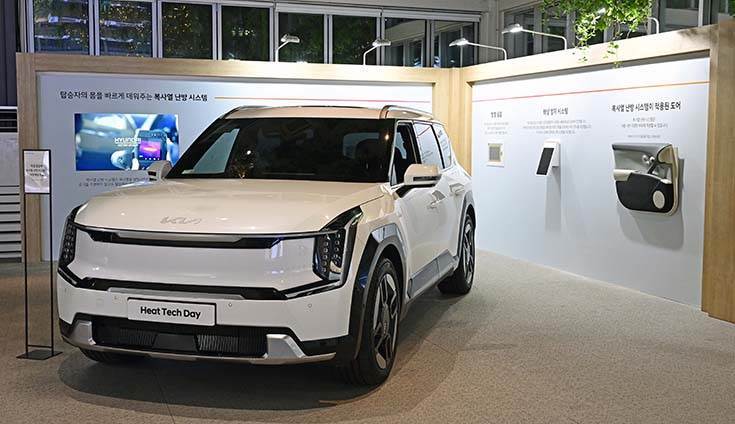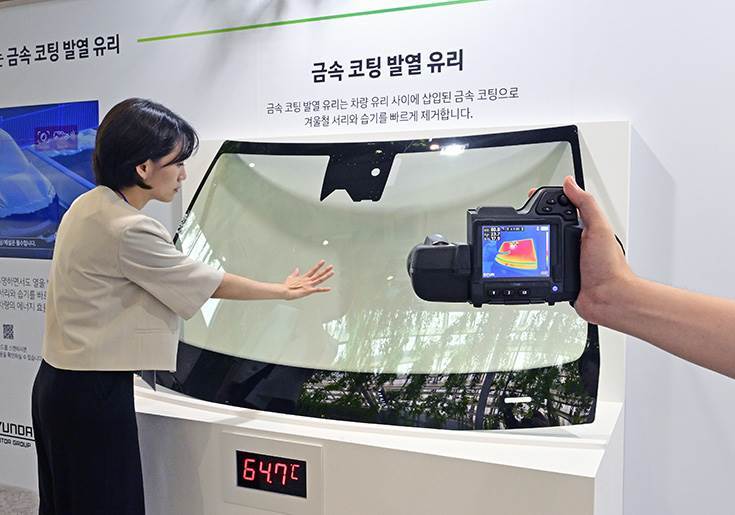Hyundai Motor Company and Kia Corporation have unveiled three technologies designed to closely regulate vehicle interior temperature to deliver enhanced passenger comfort and energy efficiency at ‘Heat Tech Day’ in Seoul, South Korea.
The event showcased Hyundai Motor and Kia’s R&D achievements in temperature control, a crucial aspect of passenger comfort. As vehicles evolve beyond simple transportation and become living spaces, the companies are developing various temperature control technologies to meet the evolving needs for comfort in mobility. These technologies not only improve comfort but also save energy, allowing efficient management of vehicle energy in the era of electrification.

The three technologies, which are at the level of technological maturity suitable for mass production, are:
Nano Cooling Film – this material significantly lowers interior temperature in hot weather when applied to vehicle glass.
Radiant Heating System – quickly and efficiently raises the perceived temperature around passengers in cold weather.
Metal-Coated Heated Glass – a world-first 48V system quickly transmits heat from the electrically powered metal coating to the glass, removing frost and moisture.
“The three technologies unveiled today are closer to customers than any other technology,” said Young Ho Jung, Vice President and Head of Thermal Energy Total Development Group at Hyundai Motor Company. “We are developing technologies to provide the most pleasant environment, considering every moment that customers experience in mobility.”

Nano Cooling Film, which comprises three layers, including two that reflect solar energy and one that emits mid-infrared wavelength, demonstrated a maximum temperature reduction of 12.5deg C.
Nano Cooling Film: reduces temperature by up to 12deg C
In July 2023, Hyundai Motor and Kia showcased various advanced nano-material technologies – particularly Nano Cooling Film, which can significantly lower a vehicle’s interior temperature.
During testing, Hyundai Motor and Kia each prepared multiple vehicles, applying Nano Cooling Film to one and leaving the other in its original state. Vehicles with regular glass and not equipped with Nano Cooling Film recorded an interior temperature of 48.5deg C, compared with 36.0deg C for the vehicles fitted with Nano Cooling Film, demonstrating a maximum temperature reduction of 12.5deg C with the advanced technology applied.
Nano Cooling Film not only blocks infra-red radiation from outside the vehicle, like traditional tinting films, but also allows heat to escape from inside the vehicle. It comprises three layers, including two that reflect solar energy and one that emits mid-infrared wavelength.
It can lower interior temperatures by more than 12deg C and can be used with existing tinting films without further impacting light transmission.
 Hyundai Motor and Kia plan to incorporate the Radiant Heating System in future models.
Hyundai Motor and Kia plan to incorporate the Radiant Heating System in future models.
Underfloor Radiant Heating System warms passengers within minutes
The Radiant Heating System is a technology designed to quickly warm passengers during winter. It uses a heating element that emits radiant heat towards passengers’ legs, quickly warming them during cold weather.
Alongside the vehicle’s existing heating system, the Radiant Heating System could conserve up to 17% more energy to reach a desired temperature, also saving time to reach this condition; the system delivers warmth to the lower body within three minutes, greatly enhancing passenger comfort.
Combined, the Radiant Heating System is expected to significantly extend the driving range of electric vehicles in winter by reducing energy used for climate control.
The system comprises a high-temperature film-type heating element and a burn prevention system. The heating element, which can reach 110deg C, is wrapped in a fabric material that emits infra-red rays and adjusts the heat to a comfortable level. A burn prevention system detects body contact and immediately lowers the temperature, improving safety by eliminating burn risks.
On Kia’s Radiant Heating System-equipped EV9, nine heating panels are installed, including on the steering column base, driver’s door and centre console, as well as the passenger door and glove box base.
Hyundai Motor and Kia plan to incorporate the Radiant Heating System in future models.

Metal-Coated Heated Glass: removes frost and moisture to improve visibility
The pioneering Metal-Coated Heated Glass system quickly removes frost or moisture from a vehicle windshield during winter, offering improved visibility and increased safety compared with regular tungsten wire heating elements. Metal-Coated Heated Glass is invisible, providing a clear, undistorted view for occupants.
The 48V system can completely defrost the glass surface within five minutes at -18deg C, up to four times faster and consuming around 10 percent less energy compared with conventional air-conditioning systems. Additionally, on hot days, the metal coating can passively block at least 60 percent of solar energy, reducing cabin cooling requirement to significantly improve energy efficiency.
Hyundai Motor and Kia have applied for patents for Metal-Coated Heated Glass in major domestic and foreign markets, with plans to implement the technology in future vehicles.
